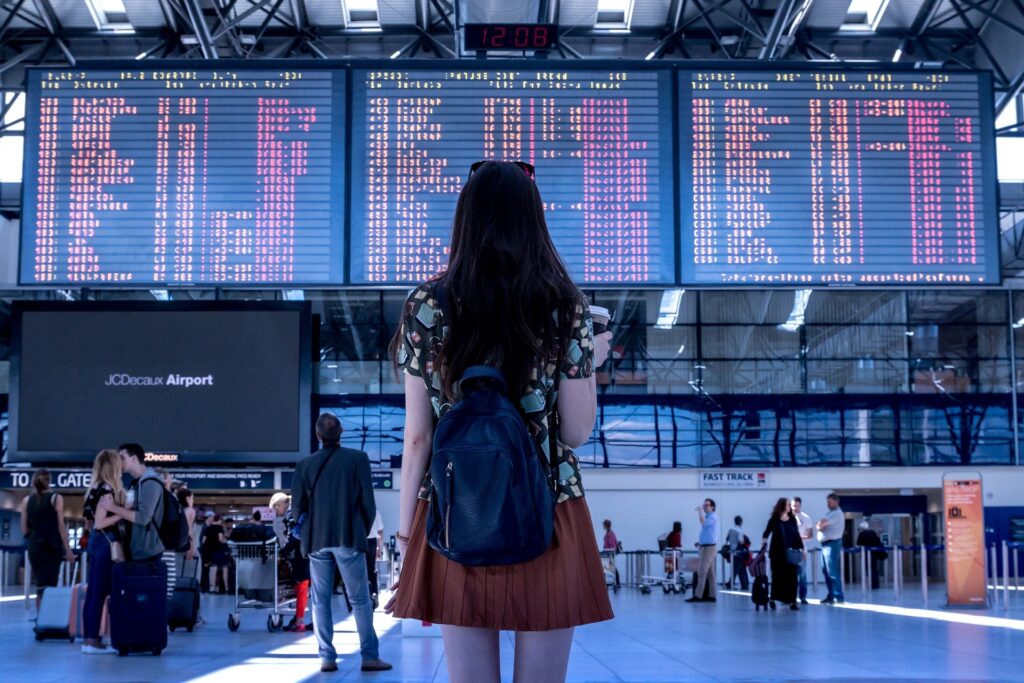With initial restrictions on social interactions being lifted in many U.S. states, policymakers must consider when and how to lift restrictions on international travel, particularly between Europe and the United States. While it is clear that international travel will remain affected for months, if not years, to come, policymakers should consider two key questions before the lifting of travel restrictions: 1) will international travel put hard-fought domestic gains at risk, potentially resulting in a rapid increase of infectious cases in the country?, and 2) will the exposure to potentially infectious travelers in transit put travelers and crew at an excessive risk of infection? The answers are complicated.
Travel Impact on Pandemic Spread
First, we know from published literature that international travel restrictions are most effective during very early stages of a pandemic (e.g. before the diseases spreads routinely in the community) as they may help slow down the transmission between regions. They are also particularly effective when a disease is regionally contained and easily detectable, as was the case of Ebola.
Among the evidence in this space is work by Joshua Epstein et al. (2007)[1], who modeled sequential (city-specific) and simultaneous (world-wide) travel restrictions and found very small difference between the two, and work by Hollingsworth, Ferguson and Anderson (2006)[2] who found that the benefits of travel bans are relatively low unless travel was completely halted yet “even at this level, travel restrictions only slow the exportation of cases rather than halting spread.” Ferguson et al. (2006)[3] suggested that “restrictions on travel will be of limited benefit in slowing global spread of a pandemic influenza outbreak that is not contained at its source.” Consistent conclusions were reached by Cooper et al. (2006)[4] and Atti et al. (2008)[5] who suggested that restrictions in travel could buy time, but not restrict community spread in a meaningful way. However, U.S. states with low infection rates such as Hawaii will likely observe more meaningful benefits due to travel restrictions.[6]
Given what we know about SARS-CoV-2 and the fact that it spreads similarly to influenza, even from asymptomatic individuals, we can conclude with a high degree of confidence that travel restrictions in their current form have a marginal effect on the course of the disease in the United States, and that their gradual lifting should be considered, starting with essential family and business travel.
Transmission Risk in Transit
Second, transmission from possibly infected travelers (whether on domestic or international flights) and other travelers and crew is of great concern. Transmission to passengers and crew has been documented in the past, including diseases like influenza, tuberculosis and severe acute respiratory syndrome (SARS).[7]
Commercial airliners commonly use HEPA filters to reduce the risk of pathogen transmission during travel[8] but research suggests that even with advanced filtration systems, virus particles can travel over a distance of more than 3 rows in the absence of masks and other precautions[9,10]. This is reflected in WHO guidelines for tracking possible tuberculosis transmission onboard commercial aircraft, which define a close contact as a “a passenger who was seated in the same row or in the two rows in front of or behind the index case.”[11]
What does this evidence suggest for the risk of transmission of SARS-CoV-2 to travelers and staff onboard? Most importantly, despite effective air filtration, risk of transmission en route will be elevated due to close proximity between passengers. Policies to reduce the risk may range from a requirement to wear face protection, use hand-sanitization and a pared down meal service to reducing crowding onboard and at the airport as much as possible. Health checks may be required prior to boarding, but an absence of fever, for example, will not rule out the possibility of asymptomatic transmission. Travel operators (airports, airlines etc.) may consider hazard pay, expanded sick benefits to at-risk staff, liability waivers and providing professional-grade protective gear to flight crew and others in close and frequent proximity to travelers. They should also report relevant passenger information for tracking and other interventions to the CDC.
How to Lift Restrictions?
A measured approach would start with the lifting of travel restrictions on those arriving from lower-risk countries first, including those with a lower or comparable active infection rates as the United States and those that test in high numbers. Only Qatar has a higher per-capita rate of active infections than the U.S., and many advanced economies have been testing as much or more than the U.S. (including Denmark, Portugal, Israel, Estonia, Ireland, Italy, Austria, Norway, Switzerland, Germany, Canada, the Czech Republic and many others).[12] Travel elsewhere is slowly coming back to normal, too. For example, many European countries are now planning to reopen borders to intra-EU travel on June 15 but have already made work-related travel between countries possible and some have been permitting students to come as well.[13,14]
In short, travel to and from lower and comparable-risk countries is unlikely to pose greater risk than travel within a country, including by air, as long as precautionary measures are put in place to protect travelers and airport, security and airline staff from avoidable risks in these challenging times.
- https://journals.plos.org/plosone/article/file?type=printable&id=10.1371/journal.pone.0000401
- https://www.nature.com/articles/nm0506-497
- https://www.nature.com/articles/nature04795
- https://www.ncbi.nlm.nih.gov/pmc/articles/PMC1450020/
- https://www.ncbi.nlm.nih.gov/pmc/articles/PMC2258437/
- https://www.ncbi.nlm.nih.gov/pubmed/19788751
- https://arc.aiaa.org/doi/pdf/10.2514/1.30272
- https://journals.sagepub.com/doi/pdf/10.1177/1010539510373130
- https://arc.aiaa.org/doi/pdf/10.2514/1.30272
- https://www.nejm.org/doi/pdf/10.1056/NEJMoa031349
- https://apps.who.int/iris/bitstream/handle/10665/43921/9789241547505_eng.pdf
- https://www.worldometers.info/coronavirus/#countries
- https://www.dw.com/en/which-european-union-countries-are-open-for-summer-tourism/a-53424062
- https://www.mvcr.cz/mvcren/article/pupils-and-students-entering-the-territory-of-the-czech-republic.aspx
